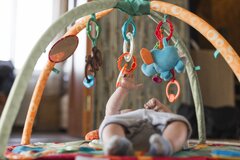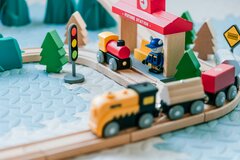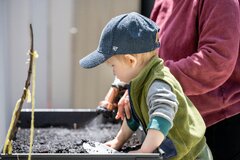Supporting your child’s fine motor skills through play
Fine motor skills are the small, precise movements we make with our hands, fingers, feet and toes. They involve co-ordinating muscles, joints, and nerves to make the movements necessary to complete a task. For example, doing up buttons, tying shoelaces, using cutlery, and so on.
Fine motor activities
Below are some ideas you might like to consider when playing with your child. These activities will support your child’s fine motor skills. As with all play activities, be led by what your child enjoys and finds most interesting. All children develop differently and at their own pace.
Objects, such as rattles and squeak toys encourage gentle and playful interactions between parents and their babies. Rattles, squeak toys and teething toys are also a way for babies to independently explore a safe object with their own hands and mouths.
 Image source: freepik.com
Image source: freepik.com
Play gyms are a way for babies to reach, grasp and pull at and interact with different objects on their own before they can sit up.
What is grasping? Grasping is an important fine motor skill that develops in stages over time. The grasping action allows your child to start to develop the strength and flexibility in their hands and fingers.
Play gyms work best when the toys and objects are changed over time. You can also hold objects above your baby and encourage them to swipe at the objects. As their reaching and grasping skills increase, you can start to gently pull on the objects which will help with your baby’s grasping skills.
High-contrast images in early baby books are interesting for little ones to look at and turning the pages of a book also supports their early fine motor development.
 Image source: freepik.com
Image source: freepik.com
Stacking rings can help babies to refine their fine motor coordination (with your help). In this action, they are practicing grabbing and using their pincer grip to pick up the pieces.
What is the pincer grip? The pincer grip is the ability to hold something between your thumb and first finger. Children use their pincer grip to pick things up and feed themselves. In the longer term, it lays the foundation for a good pencil grip when they start school.
Toys in the bath can be introduced into bath play if your child is able to sit upright on their own. Place a variety of cups and bowls in the bath and encourage them to pour water from one vessel to another.
 Image source: freepik.com
Image source: freepik.com
Building blocks help children to refine their fine motor skills, as do playing with cars and trucks. You could play a parking game, where your child is asked to ‘park’ the cars by putting them into the spaces. You can ask your child to park the cars according to size (small or big), colour, or even function (emergency vehicles versus passenger vehicles).
Posting dry spaghetti through a colander is an easy activity to set up, and easy to tidy up too.
You can also use bubble wrap. Use the hand-over-hand technique to support your child to press/push bubbles with their hand or thumb and index finger (pincer grip).
What is the hand-over-hand technique? The hand-over-hand technique is where the adult places his or her hand on the child’s hand to guide them in completing a task. This activity supports your child’s exposure to textures and sound. It also develops hand strength.
Encourage your child to tear catalogue pages into various shapes and sizes. This activity develops their use of both hands, one hand to hold the paper, and one hand to tear. This develops strength in their hands. It also helps develop hand-eye coordination.
 Image source: Ana Klipper on Unsplash
Image source: Ana Klipper on Unsplash
Children enjoy creating things through arts and crafts activities, such as finger painting or starting to paint with brushes. Over time, they may also begin to refine their painting movement, moving from using their whole arm to painting with wrist action instead, which allows them to paint with smaller movements.
Reading books together also encourages fine motor movement, as your child progresses from turning two or three pages at a time to being able to turn one page at a time.
 Image source: Jerry Wang on Unsplash
Image source: Jerry Wang on Unsplash
Small train sets support children’s fine motor development. Invite your child to create their own village with a small set of building blocks and a simple train set.
 Image source: freepik.com
Image source: freepik.com
Playdough is a great play activity – rolling it, making balls or snakes or cookies, or cutting it up with toy plastic knife, all encourages use of their fine motor skills.
You could also give your child a magazine or catalogue and kids’ scissors and get them to cut out their favourite images and make collages. They can glue those pictures onto a fresh page to make a collage. They will need your help with this.
 Image source: Arren Mills, Unsplash
Image source: Arren Mills, Unsplash
Giving them chalk to write on the ground outside can be another fun way for your child to work on their fine motor skills.
Getting your child to hang up their artwork then on the wall, using clothes pegs onto string is another quick way to work on their pincer grip, concentration and hand-eye coordination.
Sticker books are another good play activity. Peeling off the stickers and placing them on the page develops their pincer grip also. Simple board games that require moving pieces also encourage fine motor skill development.
 Image source: Christopher Luther, Unsplash
Image source: Christopher Luther, Unsplash
Children can in participate in a variety of household activities, including cooking, cleaning and gardening. You can judge best what level of involvement in household activities suits your child best.
More information on this website
- See our page on What are fine motor skills?
- See our page on Sensory Play
- See our page on The importance of play
- See our page on Pre-writing and handwriting skills
- See our page on Independence skills
Page created: 13 August 2025
First review due: 13 August 2026